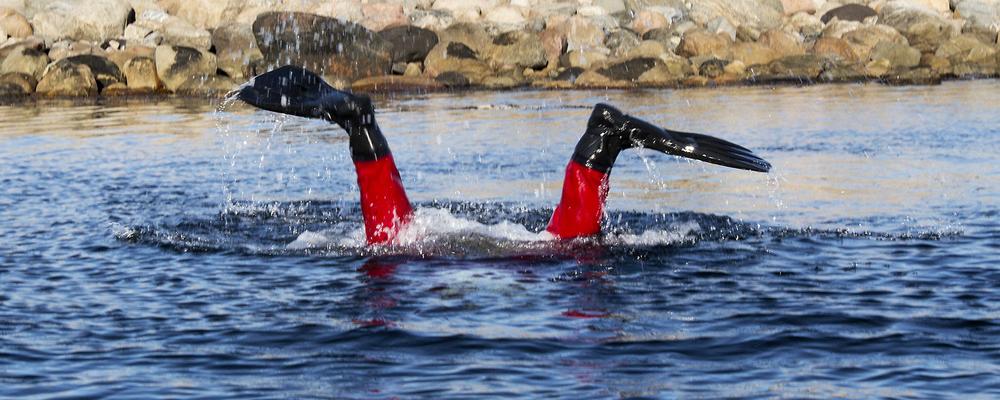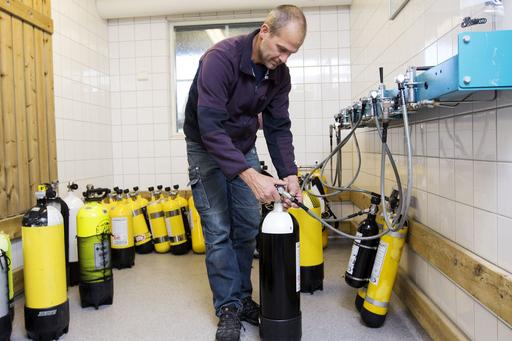
Diving and snorkelling
For marine scientists, scientific diving is an important tool to observe, document and perform empirical studies in the coastal environment. At Tjärnö Marine Laboratory, researchers and students perform scientific diving or snorkelling in research, in studies, for competence and during time off from work/studies.
General rules for diving
Before planning all types of diving at Tjärnö Laboratory and well in advance, contact diving activity supervisor for further instructions and issuing of diving permit.
When diving, bring always mobile phone.
At Tjärnö Laboratory, all diving for study, research and collection of materials, these regulations apply:
- The Swedish Work Environment Authority Statutes - Diving Work (AFS 2023:13, chapter 6, in Swedish)
- Diving rules at University of Gothenburg (pdf). Employees at the University of Gothenburg find them in the Staff portal. Others shall contact diving activity supervisor.
Scientific diving / professional diving
For lighter scientific diving in duty (researchers, visiting scientists, postgraduate students and other staff) the diver shall:
- have a valid professional diving certificate at least in line with Swedish certificate S30 (corresponding to IDSA Level 1) or a European Scientific Diver (ESD) Certificate
- have completed and been approved for diving at a medical checkup according to AFS 2023:15 (in Swedish) or have an equivalent foreign certificate
- have undergone CPR training within the last three years
- when using any project owned / personal diving equipment, it must be CE marked and comply with regulations from The Swedish Work Environment Authority and have completed service / maintenance by authorized diving company within the past 12 months
- have a certificate from head of department / employer, that the person is trained, approved and insured for the specified diving work
More complex projects (for example dives in water with strong currents, under ice, offshore, at larger depths or where heavy equipment is used) may incur additional competence requirements.
Regulations for scientific diving
A diving supervisor shall plan and, at the dive site, lead and supervise diving operations. The one who will lead a dive shall be trained at least in line with Swedish diving supervisor S30 (DykL S) or Advanced European Scientific Diver (AESD) but at more complicated tasks, additional skills may be required.
Before the dive, written Dive plan and Risk assessment shall be carried out by the diving supervisor. This shall be archived.
After the dive, dives shall be logged in the digital dive journal of the University of Gothenburg. To get access to the dive journal, contact diving activity supervisor. The diver is also responsible for dive documentation in his/her private logbook.
A dive team at scientific diving / work diving shall consist of at least 3 persons; a diving supervisor with at least DykLS or AESD certificate, a diver and a standby diver, both with at least S30 or ESD certificate. The diving supervisor determines in dive planning / risk assessment, whether more persons should join the dive team to carry out the dive safely.
Report incident
Any diving incident shall be reported in the system for incident and deviation management (IA), which employees at the University of Gothenburg find in the Staff portal. Others shall contact diving activity supervisor. It shall also be described in form for report on diving incident, which can be downloaded from this web page.
Rental of diving equipment
Diving equipment can be rented from Kristineberg Marine Research Station. Contact diving activity supervisor there.
All diving is optional.
Cooperation on scientific diving
The Marine Infrastructure cooperates with YRGO (Yrkeshögskolan i Göteborg) (in Swedish), Dykarskolan i Stockholm, Svenska vetenskapsdykarkommittén (VDK), Nätverk svensk dykning (NSD) and European Scientific Diving Panel (ESDP) in order to develop scientific diving nationally and internationally and to promote safety around scientific diving.
Scuba diving within education
When diving as part of university studies, training and skills development, the diving supervisor determines what previous skills is required for the individual dive. According to Diving regulations at the University of Gothenburg, the diver performing diving within education shall:
- have a minimum level of proficiency of CMAS**, PADI Rescue Diver or equivalent certification level for scuba divers
- have completed and been approved for diving at a medical checkup according to AFS 2023:15 (in Swedish) or have an equivalent foreign certificate
- have undergone CPR training within the last three years
- if using any personal diving equipment diving equipment, it must be CE marked and comply with regulations from The Swedish Work Environment Authority and have completed service / maintenance by authorized diving company within the past 12 months
The smallest diving team within education consists of 3 persons; a dive supervisor with at least DykLS or AESD certificate, the person undergoing the training and a diver with a minimum of S30 or ESD certificate. The diving shall be planned and documented as scientific diving.
Recreational scuba diving
Recreational diving is an opportunity for students and staff to experience the environment they work in. It can also promote training to become a scientific diver. University of Gothenburg has no responsibility for what staff and students do in their spare time but work at a field station often means spending leisure time at the station. At leisure time you are allowed to rent boats and use diving facilities or compressor, if you have the required skills. The diver should then:
- have a minimum skill level of CMAS**, PADI Rescue Diver or equivalent certification level for scuba divers
- be able to show a valid declaration of health / medical examination according to recommendations from SSDF or another educational system
- have undergone CPR training within the last three years
- if using personal diving equipment, you must present service certification of the equipment according to recommendations from manufacturer
- have a diving included leisure time accident insurance
- conduct dives according to Svenska sportdykarförbundets (SSDF) diving practice (in Swedish)
Free diving
When free diving, weight belt is used but no compressed air and one submerges to maximum 10 m depth. It may be used for observations and lighter work. More detailed description of rules as well as other useful information can be seen on a wall in the Diving facility as well as in Snorkelling and free diving (PDF) on this webpage. You will also find Risk assessment, Free diving (PDF), which has to be filled in and approved before free diving trip.
Snorkelling
When snorkelling, neither compressed air nor weights are used and one submerges to maximum 2 m depth. It may be used for observations and lighter work. Before snorkelling, a simplified risk assessment has to be conducted (only for self-reflection and does not have to be approved by staff). More detailed description of rules as well as other useful information can be seen on a wall in the Diving facility as well as in Snorkelling and free diving (PDF) on this webpage.
Diving facility
At Tjärnö Laboratory there are trained diving supervisors and diving personell able to give dive support to research projects. Pricing for this is equivalent to staff salary costs under defined mission.
In the Diving facility there is a compressor to fill the breathing air (200 and 300 bar). Compressor is serviced once a year and air quality checked at least once a year. Air filters are changed regularly.
Safety equipment, to borrow: Oxybox, first aid kit, knife, alpha flag, rescue net, current lines and lifelines.
At Tjärnö Laboratory there are 30 sets of snorkelling equipment (mask, snorkel, wetsuit, fins and weight belt) for lending.
Boats for diving can be rented from the field station.
In the Tjärnö Laboratory Diving facility you can rinse, dry and store diving equipment and perform basic maintenance. Adjacent to the Diving facility we also has shower, sauna and locker rooms.

Contact
Diving activity supervisor
Gunnar Cervin, +46 31 786 96 89
Diving register supervisor
Gunnar Cervin, +46 31 786 96 89
Diving supervisors
Gunnar Cervin, Pierre De Wit, Kristoffer Stedt and Gunilla Toth
